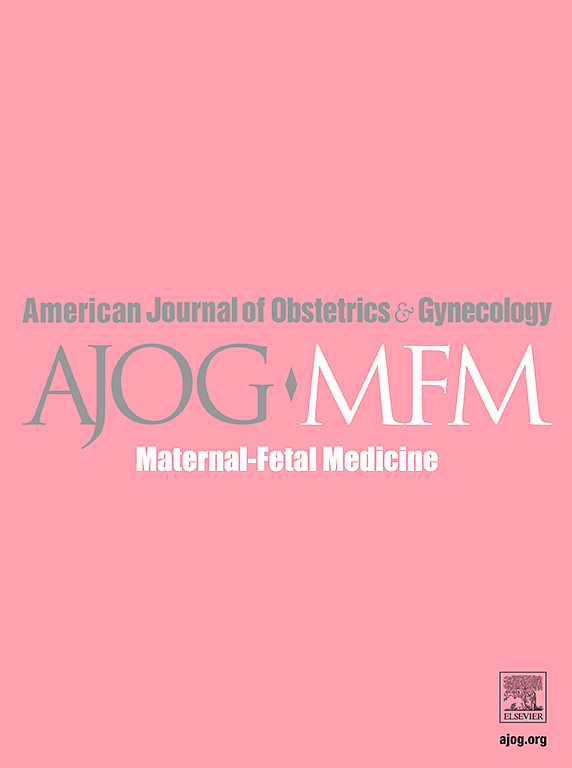先兆子痫诊断前和诊断时的母体脂蛋白-胆固醇:一项系统综述。
IF 3.8
2区 医学
Q1 OBSTETRICS & GYNECOLOGY
American Journal of Obstetrics & Gynecology Mfm
Pub Date : 2025-02-20
DOI:10.1016/j.ajogmf.2025.101654
引用次数: 0
摘要
目的:广泛的内皮功能障碍被认为是子痫前期母体症状的基础。内皮功能障碍与循环脂蛋白-胆固醇水平异常密切相关。本系统综述旨在评估母体循环高密度脂蛋白-胆固醇(HDL)、低密度脂蛋白-胆固醇(LDL)和极低密度脂蛋白-胆固醇(VLDL)在子痫前期诊断前或诊断时是否发生改变。这可能有助于了解子痫前期的发病机制,以及这些脂蛋白胆固醇在区分子痫前期妊娠和正常妊娠中的预测和诊断作用。数据来源:在OVID Medline, EMBASE, CINAHL和b谷歌Scholar中进行了文献检索,从成立到2024年4月,报告了正常妊娠和子痫前期妊娠中HDL, LDL和VLDL水平的研究。研究资格标准:选定的研究包括以下人群:孕妇,暴露于先兆子痫,在怀孕特定三个月期间收集的血液样本和至少1个主要结局(HDL, LDL或VLDL)。两名审稿人参与研究选择。研究排除了伴有其他子痫前期危险因素的孕妇(如:既往高血压、糖尿病、肥胖)和其他妊娠相关高血压疾病(妊娠性高血压、子痫、HELLP综合征)。方法:采用纽卡斯尔-渥太华量表对纳入的研究进行病例对照、队列研究和横断面研究的质量评估。结果:共纳入41项研究。这些研究的质量总体上是好的,但是59%的研究没有控制所采集血液样本的胎龄。在子痫前期诊断前的第1、2或3个月,没有发现HDL或LDL的一致变化。在2/2的研究中,VLDL在子痫前期诊断前(妊娠2 ~ 23周)或妊娠3个月的水平显著升高。在妊娠晚期诊断子痫前期后,9/11研究中VLDL水平显著升高,15/19研究中HDL水平显著降低。结论:VLDL是高度致动脉粥样硬化的,其在子痫前期诊断前和诊断时的升高提示在子痫前期内皮功能障碍的发病机制中起作用。VLDL和HDL都显示出作为前瞻性(仅VLDL)和子痫前期诊断生物标志物的前景。本文章由计算机程序翻译,如有差异,请以英文原文为准。
Maternal blood lipoprotein cholesterol prior to and at the time of diagnosis of preeclampsia: a systematic review
OBJECTIVE
Wide-spread endothelial dysfunction is thought to underlie the maternal symptoms of preeclampsia. Endothelial dysfunction is strongly associated with abnormal circulating lipoprotein cholesterol levels. This systematic review aimed to assess whether maternal circulating high-density lipoprotein cholesterol, low-density lipoprotein cholesterol, and very-low-density lipoprotein cholesterol levels were altered before or at the time of preeclampsia diagnosis. This may provide an understanding of the pathogenesis of preeclampsia and the predictive and diagnostic utility of lipoprotein cholesterol levels in distinguishing pregnancies complicated by preeclampsia from normal pregnancies.
DATA SOURCES
Literature searches were conducted in Ovid MEDLINE, Embase, Cumulative Index of Nursing and Allied Health Literature, and Google Scholar from inception to April 2024 for studies reporting high-density lipoprotein, low-density lipoprotein, and very-low-density lipoprotein levels in normal pregnancies and pregnancies complicated by preeclampsia.
STUDY ELIGIBILITY CRITERIA
The selected studies included the following: population of pregnant women, exposure to preeclampsia, blood samples collected during a specific trimester of pregnancy, and at least 1 primary outcome (high-density lipoprotein, low-density lipoprotein, or very-low-density lipoprotein). Of note, 2 reviewers were involved in the study selection. The excluded studies included pregnancies complicated by other risk factors for preeclampsia (eg, preexisting hypertension, diabetes mellitus, and obesity) and other pregnancy-related hypertensive disorders (pregnancy-induced hypertension, eclampsia, and hemolysis, elevated liver enzymes, and low platelet count).
METHODS
The quality of the included studies was evaluated using the Newcastle-Ottawa Scale for case-control, cohort, and cross-sectional studies.
RESULTS
A total of 41 studies were included. The quality of the studies was generally good. However, 59% of the studies did not control for the gestational age at which the blood samples were collected. No consistent change in high-density lipoprotein or low-density lipoprotein levels was found before preeclampsia diagnosis in the first, second, or third trimesters of pregnancy. Very-low-density lipoprotein was significantly elevated in 2 of 2 studies that reported levels before preeclampsia diagnosis in the late second (>23 weeks of gestation) or third trimester of pregnancy. After preeclampsia diagnosis in the third trimester of pregnancy, very-low-density lipoprotein levels were significantly elevated in 9 of 11 studies, and high-density lipoprotein levels were significantly decreased in 15 of 19 studies.
CONCLUSION
Very-low-density lipoprotein is highly atherogenic, and its elevation before and at the time of preeclampsia diagnosis suggests a role in the pathogenesis of the endothelial dysfunction associated with preeclampsia. Both very-low-density lipoprotein and high-density lipoprotein show promise as prospective (very-low-density lipoprotein–only) diagnostic biomarkers for preeclampsia.
求助全文
通过发布文献求助,成功后即可免费获取论文全文。
去求助
来源期刊

American Journal of Obstetrics & Gynecology Mfm
Medicine-Medicine (all)
CiteScore
7.40
自引率
3.20%
发文量
254
审稿时长
40 days
期刊介绍:
The American Journal of Obstetrics and Gynecology (AJOG) is a highly esteemed publication with two companion titles. One of these is the American Journal of Obstetrics and Gynecology Maternal-Fetal Medicine (AJOG MFM), which is dedicated to the latest research in the field of maternal-fetal medicine, specifically concerning high-risk pregnancies. The journal encompasses a wide range of topics, including:
Maternal Complications: It addresses significant studies that have the potential to change clinical practice regarding complications faced by pregnant women.
Fetal Complications: The journal covers prenatal diagnosis, ultrasound, and genetic issues related to the fetus, providing insights into the management and care of fetal health.
Prenatal Care: It discusses the best practices in prenatal care to ensure the health and well-being of both the mother and the unborn child.
Intrapartum Care: It provides guidance on the care provided during the childbirth process, which is critical for the safety of both mother and baby.
Postpartum Issues: The journal also tackles issues that arise after childbirth, focusing on the postpartum period and its implications for maternal health. AJOG MFM serves as a reliable forum for peer-reviewed research, with a preference for randomized trials and meta-analyses. The goal is to equip researchers and clinicians with the most current information and evidence-based strategies to effectively manage high-risk pregnancies and to provide the best possible care for mothers and their unborn children.
 求助内容:
求助内容: 应助结果提醒方式:
应助结果提醒方式:


